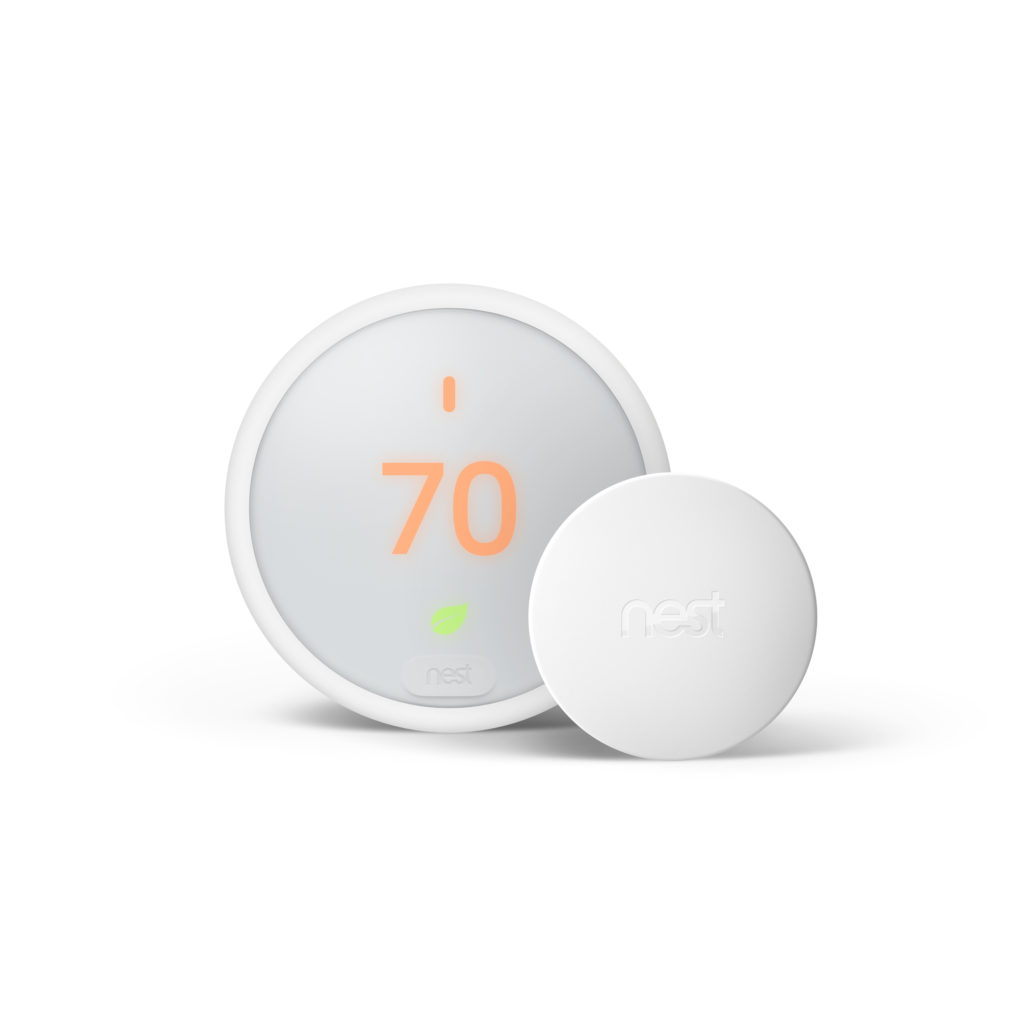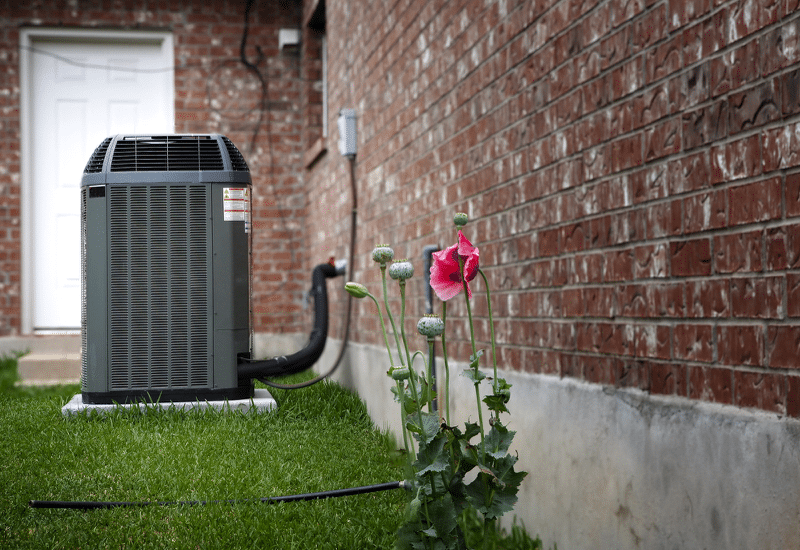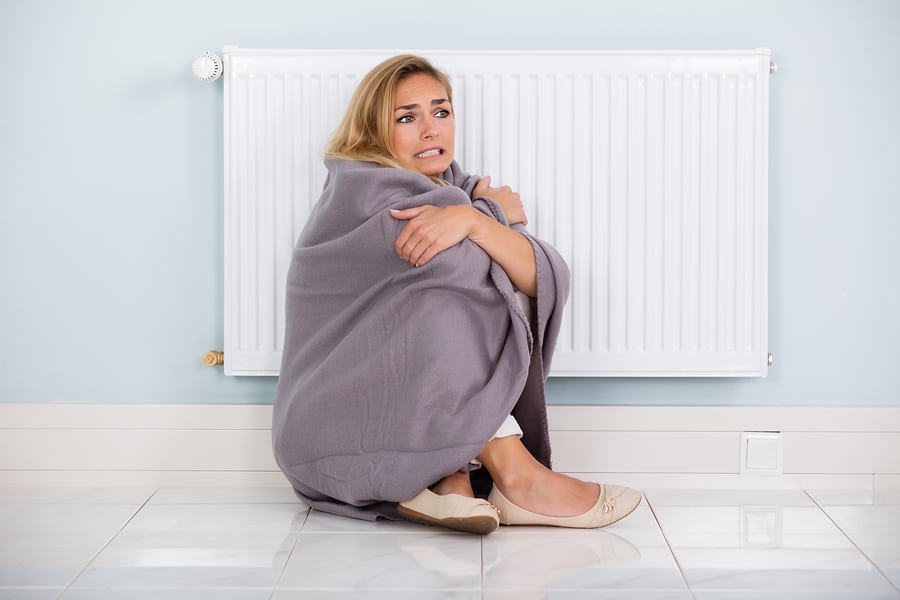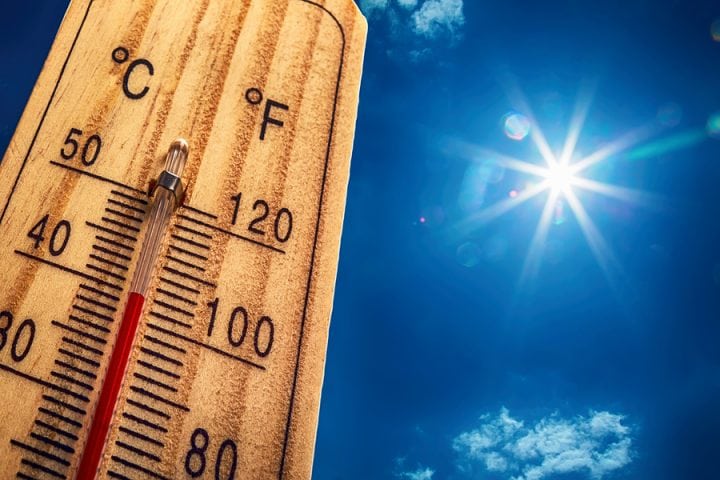What Is the Nest Temperature Sensor & What Are Its Benefits?

Why Homeowners Love Nest
Running a home air conditioning or heating system can be expensive -- not to mention unreliable, spotty, and sometimes unpredictable with temperatures throughout the house. That’s why so many homeowners have turned to Nest technology. Nest thermostats provide proven energy savings, often paying for themselves in just a few years of operation. These smart thermostats can turn themselves off when you are away, offer maximum control from your smartphone or other devices, and have remote temperature sensing. Ultimately, the thermostats are specifically designed to help homeowners like you get optimal comfort in their homes while saving energy and money every month. Who doesn’t enjoy smart home comfort?
Nest changes the game for heating and cooling, especially now that the Nest Temperature Sensor elevates home thermostat control even further. Whether you currently have a Nest thermostat installed or are considering the full package, our HVAC experts are here to help you determine if all the bells and whistles are worth it.
How Having the Sensor Can Help Your Home Comfort
Working with both the 3rd-generation Nest Learning Thermostat and the more affordable Nest E Thermostat, the Nest Temperature Sensor can be a crucial component of any smart home. When you want ultimate control of your multi-level house or specific rooms, the sensors allow you to have simple and effective management for an affordable price. The sensor connects to your Nest via bluetooth and will begin to measure temperatures and send back reports to the thermostat so that it can make accurate adjustments.
Here are some of the key reasons to consider investing in these sensors:
- Keeps a room the exact temperature you want
- Allows you to prioritize certain rooms and areas
- Easily set up on a shelf or room wall
- Connects to the Nest app and does the rest from there
- Provides precise, complete control of your home
Typical homes will only have one thermostat. However, fluctuating temperatures room to room or in an upstairs area can make it difficult to achieve ideal comfort. Having Nest Temperature Sensors throughout desired rooms or areas of the house allows a homeowner to fine tune their thermostat to their exact preferences without breaking the bank. You can even schedule the temperature based on the time day of you use each area of the house! That means you can say goodbye to a freezing cold kitchen in the morning after you’ve had a cozy night sleep and forget about wasting cool air in rooms you won’t be in the rest of the day or until evening.
Find Out If You Need the Nest Temperature Sensor
Can you still work your thermostat and HVAC system to provide reliable comfort throughout your home without a Nest thermostat and sensor? Sure. You certainly won’t get the accuracy, reliability, and cost savings that a fully integrated smart thermostat system can provide though. For many homeowners, having a complete Nest system is viewed as a smart home investment. Not only does it provide immediate benefits, long-term savings, and energy conservation, it also means added home value down the road and other great benefits.
If you are frustrated with hot and cold spots throughout your home, tired of expensive AC or heating bills when your home temperature doesn’t even feel all that comfortable, NexGen is here to review your options. While a Nest thermostat and Temperature Sensor can be a great addition, we are available to help you assess your entire system and determine the best course of action for optimizing your home comfort.
You deserve to enjoy ideal temperatures in your own home. Call NexGen today to get our expert opinion on your heating and cooling options!
Call NexGen Today
Our expertise and commitment to customer satisfaction make us the leading HVAC company in Southern California. To learn more about our equipment, services, and protection plan,
book an appointment online or call
888-277-0415.
How cool should my house be if it's over 100 outside?

The summer temperatures in Palm Desert, California are here and it's HOT outside. Many people have received their second or third summer electric bills – and they're literally breaking out in a sweat over the amount due!
When it's about 110 degrees in Palm Desert, Palm Springs, or Indio, California, it's hot enough for anyone and anything. Learn the best way for you to set your thermostat this summer – even if it's not exactly what you want to hear or you prefer a relatively chilly indoor air temperature.
The Case for a Warmer Indoor Air Temperature
Making “the case” for a warmer indoor air temperature during the summer rests on three truisms:
- The longer your air conditioner runs, the higher your electric bill will be.
- The lower you set your thermostat, the longer your air conditioner will run and the higher your electric will be.
- Therefore, the more you can reduce the difference between the outdoor temperature and your indoor temperature, the less your air conditioner will run and the lower your summer air conditioning bills will be.
The California Energy Commission recommends that homeowners set their thermostat to 78 degrees when they're home and 85 degrees when they're away from home during the summer. Note that this is a better strategy than turning off your air conditioner on 100-degree days – so that you don't return home to indoor air that feels like a sauna, and so that your air conditioner won't have to run as long to cool your home upon your return.
The center's advice is based on the U.S. Department of Energy's often repeated mantra about thermostat controls and saving energy: when you can adjust your thermostat by between 10 and 15 degrees for eight hours at a stretch – higher during the summer and lower during the winter – you can save between 5 and 15 percent on your utility bill. This one adjustment can add up to considerable savings, though it might mean sticking with a minimalist wardrobe during the summer (and reaching for a sweater during the winter).
Keep Your Cool
Admittedly, some people simply do not tolerate warm weather well. And some people suffer from health issues that make a cool indoor air temperature an absolute necessity.
Be sure to make allowances for such conditions and take proactive measures to help you stay cool indoors with or without air conditioning -- and even before the temperature soars to three digits outdoors:
- Close your window treatments during the day when the sun is out.
- Turn your ceiling fans in a counterclockwise direction. Doing so will create a literal wind-chill effect that should allow you to set your thermostat about 4 degrees higher than usual -- and you won't feel one bit warmer.
- For the same reason, place table and floor fans in strategic places, such as to cool down the kitchen while you're cooking.
- Make good use of kitchen and bathroom exhaust fans to force heat and humidity to dissipate in a hurry.
- Turn on your whole-house fan in the evening, when temperatures drop outdoors, to bring cooler air into your home and maybe even give your air conditioner a break.
- Drink plenty of water to stay hydrated.
When it's 100 degrees outdoors, you're likely to feel the heat indoors. Ensuring that your home is properly sealed and insulated against air leaks will mitigate your discomfort – and help keep your utility bills in check.
Call NexGen HVAC & Plumbing
Our expertise and commitment to customer satisfaction make us the leading HVAC company in Southern California. To learn more about our equipment, services, and protection plan, book an appointment online or call 888-277-0415.
How to Prepare Your HVAC System for Spring

As winter melts away and birds begin to chirp, you’ve told yourself multiple times: “I need to look into how to prepare my HVAC system for spring.”
Wise homeowners will ensure that their air conditioner is in top working order for that first warm day. By following the five tips below, you can be ready when summer weather hits and set yourself up for energy-efficient and cost-effective cooling all summer long.
1. Change Your HVAC Filters
If you want to know how to get rid of allergies this spring, you can begin by simply replacing the furnace filter on your HVAC system. As every allergy sufferer knows, spring brings ample amounts of pollen and other airborne allergens. Remove these seasonal allergens from your home with a brand-new furnace filter. If your air conditioning unit employs additional air filters of any kind, you should replace each of these as well. There’s no telling what has settled on them over the long winter months!
2. Inspect the Ducts and Insulation
Leaking ducts and missing insulation on your HVAC system will have your air conditioner working overtime. A professional technician can insure that your ducts are airtight and well-insulated, leading you to cheaper monthly utility bills throughout the summer. Hate warm spots in your otherwise cool home? An optimized duct system will ensure that each corner of each room has an even and comfortable temperature.
3. Make Sure That Your HVAC System is Clean
Although a new furnace filter can work wonders in terms of the overall air quality of your home, the dirt that already rests within your duct system can quickly clog it. For this reason, experts recommend scheduling professional duct cleaning every five to seven years. Homeowners should also ensure that all indoor and outdoor air conditioning equipment/infrastructure is completely free of dirt and debris. When it comes to outdoor air conditioning units, you must also protect against invading plants and pests that may cause unexpected damage. Keep grass and weeds away from all vents and call a pest control specialist to handle any insect/animal intruder.
4. Consider a Programmable Thermostat
When you’re at work or outside in the summer sunshine, you simply don’t need to cool an empty house. Stop running your air conditioner constantly by installing a programmable thermostat. Unlike traditional thermostats that must be set by hand, this device incorporates a timer that can trigger a new temperate setting for each hour of the day and night. It even knows the difference between a Wednesday (when you’re hard at work) and a Saturday (when you’re relaxing around the house).
5. Schedule a Spring HVAC Tune-Up
To get the most out of your HVAC system, you should schedule professional maintenance visits at least twice a year. For all of the reasons detailed above, spring is an ideal time for one of these visits. In addition to inspecting, cleaning, and/or repairing your ducts, you can ensure that all components of your air conditioner are in perfect working order. And a trained HVAC technician can also install that programmable thermostat you’ve been considering!
NexGen Air provides comprehensive HVAC services for both residential and business clients. Schedule your seasonal tune-up with NexGen Air today before spring has sprung!
Call NexGen Today
Our expertise and commitment to customer satisfaction make us the leading HVAC company in Southern California. To learn more about our equipment, services, and protection plan,
book an appointment online or call
888-277-0415.
Reasons Your Heater is Blowing Cold Air

Expert Heater Repair in Los Angeles
Having a heater or heating system that blows cold air is a common problem. However, if you don’t take the right steps right away, this might cause you to incur heavy replacement costs. So the first time you feel a blast of cold air from your heater, here are a few things which need your attention.
Sometimes, these issues are easy to fix and you can resolve them on your own. At other times, you may need the assistance of a professional HVAC service to restore the proper functionality of your heater.
Common Issues with Heaters Blowing Cold Air
Thermostat Settings
The most frequent reason heaters malfunction can be a faulty thermostat. The thermostat is a major component of any heating system and where major HVAC issues begin.
Take a look at the thermostat and set it to ‘auto’ instead of ‘on’. When you keep your thermostat to ‘on’ mode, it constantly runs its fan to blow out air, even when your furnace is not actually heating.
Pilot Light Gone Out
Another possible reason for getting cold air out of your heater could have to do with the pilot light. Chances are that the pilot light is out. The pilot light is the small flame that lights when you turn on the heater. Sometimes you just need to re-light the pilot light in order to fix the problem. Also, the gas valve of your heater may be shut off if you are using a gas heater.
Also, make sure that you are receiving gas at full pressure in your home. You can do this by checking your gas-powered oven or stove. In the case of the electric furnace, check the connections and make sure that you are receiving adequate power.
Inspect Air Filters
Clogged air filters are another reason you could be experiencing cold air from your heater. A restricted or limited air flow can cause your heater to overheat. As a safety precaution, this overheating shuts off your heater’s burners. This safety control is installed to prevent damage to your furnace. So inspect the air filters and clean them to allow proper air flow, cleaning them every month, and replacing them every three months.
Duct Problems
When your duct is leaking, it makes you feel as if your furnace has stopped working. This happens because the cold air from outside your attic easily crawlspace and enters your house through these duct holes. So before you blame your heater for malfunctioning, first check your duct for any leaks or cracks. This is relatively an easy issue to fix as opposed to calling up the assistance of an electrician to fix the heating system.
Speaking of which, not every heating system issue can be fixed as a DIY project. Therefore, don’t hesitate in taking the assistance of a professional, nor should you simply overlook the issue altogether.
Call NexGen Today
Our expertise and commitment to customer satisfaction make us the leading HVAC company in Southern California. To learn more about our equipment, services, and protection plan,
book an appointment online or call
888-277-0415.
The Dangers of High Temperatures in California

High temperatures aren’t just a risk to your health, but your home’s HVAC system. The summer brings with it the sweltering heat and humidity, and sometimes those temperatures can escalate to dangerous degrees. Most homeowners rely heavily on their air conditioners to combat the heat, but over time those intense temperatures can wear down your ac unit. Luckily there are a few tricks you pull from your sleeve to protect yourself and your air conditioner.
How You Can Maintain Your Air Conditioner in High Temperatures
There’s only so much you can do to fight the heat, but that doesn’t mean you or your air conditioner have to take it lying down. A cool and comfortable home means staying on top of what your air conditioner needs, as well as monitoring habits, and avoiding activities that emit a lot of heat. The summers in California can be intense, but that doesn’t mean you have to fret. Here’s what you can do to stay safe and avoid the miserable heat.
Invest in a digital thermostat.
It’s a common misnomer that if you keep your air conditioner running at the lowest of temperatures, it’s the best way to stave off the heat. In reality, having your air conditioner constantly circulating a 60-degree temperature throughout your house will only overwork your ac unit. Keeping the room temperature at 77-78 degrees is still comfortable despite the sweltering heat outside, and it doesn’t overstress your air conditioner. Using a digital thermostat also helps to monitor your home’s room temperature throughout the day, and to adjust it accordingly.
Replace your air filter.
Your air conditioner is an air filter that collects dust, allergens, and debris, that would otherwise be circulated throughout your house. Over time, those filters can collect enough dirt to clog the ventilation in your air conditioner. An ac unit that’s not properly ventilated will not only circulate dirty air, but it can eventually break down. To keep your air conditioner running and the air inside your house clean, it’s important to replace your air filter every 30-60 days.
Schedule yearly tune-ups.
The more maintained your air conditioner is, the better it can do its job. That’s why it’s important to schedule an annual tune-up with your HVAC specialist. An HVAC professional is trained to thoroughly inspect and fix any problems that prevent your ac unit from working effectively. The best way to take care of your air conditioner is to catch issues early, and that’s exactly what a yearly tune-up can do for you.
Keep the sun out of your house.
It sounds like an obvious idea to try and avoid the sun, but the summer heat provides several different heat traps inside your home. Closing curtains that face the sun is an easy way to block out some of the heat. Treating your windows with thermal lined curtains and window tinting helps to refract those UV rays. Planting trees and shrubs around your house can provide natural shading and a buffer between the sun and your house. Even painting your walls a brighter color can help to reflect some of that oppressive solar energy.
Monitor your habits.
Another important thing to remember is your daily habits. Several routine chores can emit a lot of heat such as using the dishwasher, oven, and dryer. If you can, avoid cooking inside and take shorter showers, as both activities contribute a lot of heat and humidity inside your home. Unplug any unused appliances, and try to keep your fridge and freezer full of food. Any electrical appliance in use will naturally generate some heat, so it’s best to monitor how and when you use these appliances.
Ventilate your home.
Ventilation is important when you’re trying to combat the heat. Closing off closets and empty rooms and using fans helps to better circulate that cool air throughout your house. Keeping your vents and air ducts clear from obstructing furniture is also very helpful and prevents your air conditioner from overworking itself.
Insulate your home.
Whatever cool air you generate, you’ll want to keep that inside your house. A house that isn’t properly insulated, however, is prone to air leaks which make it more difficult to stay cool and comfortable. Sealing leaky doors, windows, and air ducts means more cool air is circulated where it needs to go. Insulating your attics and installing attic vents will also help to keep the cold in and the heat out.
Your Health Should Never be at Stake
High temperatures put everyone at risk, causing discomfort and dehydration, and even much more fatal symptoms such as heat stroke. As a homeowner, you shouldn’t have to suffer inside the comfort of your own home, but that does mean taking proper care of your air conditioner. A scheduled tune-up with an HVAC technician is the perfect way to prepare your home for the incoming heat. Don’t wait until it’s too late, set up an appointment today.
Call NexGen Today
Our expertise and commitment to customer satisfaction make us the leading HVAC company in Southern California. To learn more about our equipment, services, and protection plan,
book an appointment online or call
888-277-0415.













